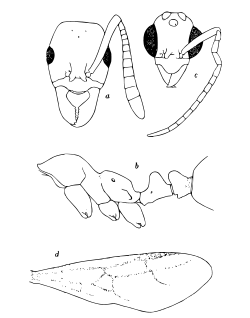Megalomyrmex symmetochus
| Megalomyrmex symmetochus | |
|---|---|
| Scientific classification | |
| Kingdom: | Animalia |
| Phylum: | Arthropoda |
| Class: | Insecta |
| Order: | Hymenoptera |
| Family: | Formicidae |
| Subfamily: | Myrmicinae |
| Tribe: | Solenopsidini |
| Genus: | Megalomyrmex |
| Species: | M. symmetochus |
| Binomial name | |
| Megalomyrmex symmetochus Wheeler, 1925 | |
Megalomyrmex symmetochus is a species of ant in the subfamily Myrmicinae. It is native to Panama.[1]
M. symmetochus was discovered by William M. Wheeler in late July 1924 in the fungus gardens of the attine Sericomyrmex amabilis of Barro Colorado Island.[2]
Description

Workers are 3 to 3.5 mm long, with small, feebly convex eyes, that are probably adapted to living within the dark fungal gardens of their host. Very small ocelli are only sometimes present. Workers are yellowish red, with mandibles, funiculi, the posterior half of the first segment of the gaster and the sutures of the thorax and pedicels brown. The tip of the gaster is yellowish.[2]
The female is almost 4 mm long. She has larger eyes than the workers and distinct ocelli. Otherwise, they look very similar to workers. Each ocellus has a black margin internally. The wings are yellowish hyaline and iridescent, with veins and pterostigma pale yellow. The membranes of the wings are distinctly pubescent.[2]
Males are almost 3 mm long. They bear very large eyes and ocelli. Their body form is very similar to that of workers and females, but with smooth sides of the thorax. The wings have longer pubescence that in the female. Males are brownish yellow, with a little darker gaster and slightly paler antennae and legs. The eyes and a spot along the inner border of each ocellus are black.[2]
References
- ↑ Social Insects Specialist Group 1996. Megalomyrmex symmetochus. 2006 IUCN Red List of Threatened Species. Archived June 27, 2014, at the Wayback Machine. Downloaded on 10 August 2007.
- 1 2 3 4 Wheeler, W.M. (1925). "A new guest-ant and other new Formicidae from Barro Colorado Island, Panama". Biological Bulletin 49: 150-181.
External links
 Media related to Megalomyrmex symmetochus at Wikimedia Commons
Media related to Megalomyrmex symmetochus at Wikimedia Commons
